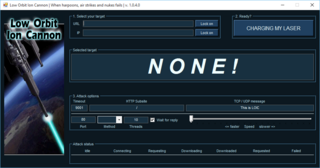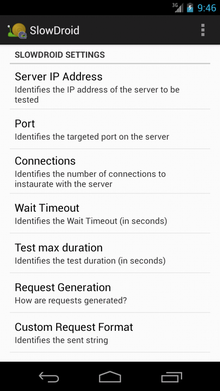
In computing, a denial-of-service attack is a cyber-attack in which the perpetrator seeks to make a machine or network resource unavailable to its intended users by temporarily or indefinitely disrupting services of a host connected to a network. Denial of service is typically accomplished by flooding the targeted machine or resource with superfluous requests in an attempt to overload systems and prevent some or all legitimate requests from being fulfilled.
A Smurf attack is a distributed denial-of-service attack in which large numbers of Internet Control Message Protocol (ICMP) packets with the intended victim's spoofed source IP are broadcast to a computer network using an IP broadcast address. Most devices on a network will, by default, respond to this by sending a reply to the source IP address. If the number of machines on the network that receive and respond to these packets is very large, the victim's computer will be flooded with traffic. This can slow down the victim's computer to the point where it becomes impossible to work on.
Network congestion in data networking and queueing theory is the reduced quality of service that occurs when a network node or link is carrying more data than it can handle. Typical effects include queueing delay, packet loss or the blocking of new connections. A consequence of congestion is that an incremental increase in offered load leads either only to a small increase or even a decrease in network throughput.

In computing, a zombie is a computer connected to the Internet that has been compromised by a hacker via a computer virus, computer worm, or trojan horse program and can be used to perform malicious tasks under the remote direction of the hacker. Zombie computers often coordinate together in a botnet controlled by the hacker, and are used for activities such as spreading e-mail spam and launching distributed denial-of-service attacks against web servers. Most victims are unaware that their computers have become zombies. The concept is similar to the zombie of Haitian Voodoo folklore, which refers to a corpse resurrected by a sorcerer via magic and enslaved to the sorcerer's commands, having no free will of its own. A coordinated DDoS attack by multiple botnet machines also resembles a "zombie horde attack", as depicted in fictional zombie films.

Satellite Internet access or Satellite Broadband is Internet access provided through communication satellites. Modern consumer grade satellite Internet service is typically provided to individual users through geostationary satellites that can offer relatively high data speeds, with newer satellites using Ku band to achieve downstream data speeds up to 506 Mbit/s. In addition, new satellite internet constellations are being developed in low-earth orbit to enable low-latency internet access from space.
In computer networks, a tunneling protocol is a communication protocol which allows for the movement of data from one network to another. It can, for example, allow private network communications to be sent across a public network, or for one network protocol to be carried over an incompatible network, through a process called encapsulation.
Bandwidth throttling consists in the limitation of the communication speed, of the ingoing (received) or outgoing (sent) data in a network node or in a network device.
The Character Generator Protocol (CHARGEN) is a service of the Internet Protocol Suite defined in RFC 864 in 1983 by Jon Postel. It is intended for testing, debugging, and measurement purposes. The protocol is rarely used, as its design flaws allow ready misuse.
A LAND attack is a DoS attack that consists of sending a special poison spoofed packet to a computer, causing it to lock up. The security flaw was first discovered in 1997 by someone using the alias "m3lt", and has resurfaced many years later in operating systems such as Windows Server 2003 and Windows XP SP2.
Delay-tolerant networking (DTN) is an approach to computer network architecture that seeks to address the technical issues in heterogeneous networks that may lack continuous network connectivity. Examples of such networks are those operating in mobile or extreme terrestrial environments, or planned networks in space.
A UDP flood attack is a volumetric denial-of-service (DoS) attack using the User Datagram Protocol (UDP), a sessionless/connectionless computer networking protocol.

Slowloris is a type of denial of service attack tool which allows a single machine to take down another machine's web server with minimal bandwidth and side effects on unrelated services and ports.
A regular expression denial of service (ReDoS) is an algorithmic complexity attack that produces a denial-of-service by providing a regular expression and/or an input that takes a long time to evaluate. The attack exploits the fact that many regular expression implementations have super-linear worst-case complexity; on certain regex-input pairs, the time taken can grow polynomially or exponentially in relation to the input size. An attacker can thus cause a program to spend substantial time by providing a specially crafted regular expression and/or input. The program will then slow down or become unresponsive.

Low Orbit Ion Cannon (LOIC) is an open-source network stress testing and denial-of-service attack application written in C#. LOIC was initially developed by Praetox Technologies, however it was later released into the public domain and is currently available on several open-source platforms.
Mobile security, or mobile device security, is the protection of smartphones, tablets, and laptops from threats associated with wireless computing. It has become increasingly important in mobile computing. The security of personal and business information now stored on smartphones is of particular concern.
MQTT is a lightweight, publish-subscribe, machine to machine network protocol for message queue/message queuing service. It is designed for connections with remote locations that have devices with resource constraints or limited network bandwidth, such as in the Internet of Things (IoT). It must run over a transport protocol that provides ordered, lossless, bi-directional connections—typically, TCP/IP, but also possibly over QUIC It is an open OASIS standard and an ISO recommendation.

High Orbit Ion Cannon (HOIC) is an open-source network stress testing and denial-of-service attack application designed to attack as many as 256 URLs at the same time. It was designed to replace the Low Orbit Ion Cannon which was developed by Praetox Technologies and later released into the public domain. The security advisory for HOIC was released by Prolexic Technologies in February 2012.
BASHLITE is malware which infects Linux systems in order to launch distributed denial-of-service attacks (DDoS). Originally it was also known under the name Bashdoor, but this term now refers to the exploit method used by the malware. It has been used to launch attacks of up to 400 Gbps.
R.U.D.Y., short for R U Dead yet, is an acronym used to describe a Denial of Service (DoS) tool used by hackers to perform slow-rate a.k.a. “Low and slow” attacks by directing long form fields to the targeted server. It is known to have an interactive console, thus making it a user-friendly tool. It opens fewer connections to the website being targeted for a long period and keeps the sessions open as long as it is feasible. The amount of open sessions overtires the server or website making it unavailable for the authentic visitors. The data is sent in small packs at an incredibly slow rate; normally there is a gap of ten seconds between each byte but these intervals are not definite and may vary to avert detection.
The term slow DoS attack (SDA) was introduced in 2013, to clearly define a specific category of denial-of-service attacks which make use of low-bandwidth rate to accomplish their purpose. Similar terms can be found in literature, such as:






